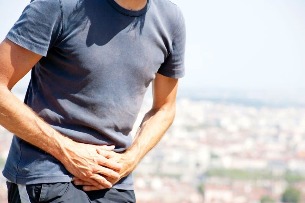Prostatitis is the most common disease in urology in men over the age of 45 years. According to the statistics, with the noah form of inflammation of the prostate gland is located to face every second man. The disease is characterized by disorders of urination and the pain syndrome. Launched a form of disease is serious and intractable the problem, therefore, treatment of prostatitis must begin in a timely manner.
The most common causes of developing the disease

To understand where that disease prostatitis and why it appears, it is necessary to understand the operating characteristics of the prostate. This hormone-dependent organ has a function that provides the vitality of the spermatozoa after ejaculation, allowing them to advance without hindrance towards the ovum. This functionality is available as a special secret, which mixes with the substance and is equal to about a third of the volume of seminal fluid.
The causes of the development of the disease can be divided into general, which increase the risk of inflammation, and specific, specific to a certain form of inflammation.
The disease develops due to the following reasons:
- the lack of a regular sexual life;
- hypothermia;
- the infection of the organ;
- bad habits;
- obesity;
- constipation;
- the lack of physical exercise;
- cardiovascular disease;
- stress.
The lack of a regular sexual life, it leads to the development of processes that are eroding, causing the inflammation. For normal operation, the prostate must be regularly and completely drained, which can be guaranteed only through sexual intercourse. Masturbation is a partial emptying of the lobules of the organ, which cannot replace the history department at the natural secretion of the prostate, such as during the flood of sexual intercourse.
Hypothermia lower part of the body causes irritation of the prostate. This weakens the immunity and can be a cause of penetration in the prostate opportunistic pathogens, which are always present in the human body. The infection of the prostate occurs in many different ways:
- with a current of blood, in the presence of a chronic focus of infection in the body;
- with the lymphatic current, when the infectious pelvic inflammation;
- through reverse mergers of urine or seminal fluid, with genital infections, cystitis, and kidney disease.
Bad habits have an indirect effect on the development of prostatitis. The fact is that with age, the prostate changes occur natural. After about 50 years slows down the secretion of the male sex hormones, the prostate grows in size. This leads to a slowing down of the metabolic processes and under the action of a series of negative factors, including smoking and alcohol abuse, appear to be congestion in the organ. It is not an inflammatory disease associated with an increase of the prostate due to the natural aging, has similar symptoms and is called the adenoma or hyperplasia of the prostate.
Another factor that acts as the cause of the development of the disease in men is obesity. Disorders of the metabolism leads to a slowing down of all processes that occur in the body. This disrupts the normal trophism of the prostate gland, the blood circulation of an organ, which develops congestion of the prostatic secret. As a general rule, when the obesity men lead a sedentary life and do not follow a proper diet. The lack of physical exercise causes a worsening of the circulation in the pelvic organs, bad diet causes constipation.
The violation of defecation, long accumulation of feces in the intestine exerts a pressure on the prostate and bothersome organ. During the emptying of the intestine, the solid bulk to stools pass to the rectum, damaging the wall. In a certain place in the prostate near the rectum, so when the difficulties of defecation, occurs in irritation of the organ, which in certain conditions can be one of the causes of the development of prostatitis. In addition, during the constipation is broken the movement of the pelvis, which results in the development of the phenomena of stagnation in the prostate.
Cardiovascular diseases and stress weakens the body. And in the first and in the second case there is a violation of the circulation (including the organs of the pelvis. Diseases of the cardiovascular system worsens the transport of oxygen to the cells of the body and the stress on all metabolic processes and weaken the immune system. To diseases of the blood vessels, can have a negative effect on the function of the prostate, can also be attributed to the varicose veins.
None of these reasons, in addition to infectious diseases, it is not a fundamental factor in the development of the disease. Considered the reasons for this are only risk factors and not result in the development of prostatitis, but also increase the risk of this disease. As a general rule, the prostatitis in men develops in the presence of several risk factors. In addition, for each type of disease is characterized by trigger factors.
Types of diseases

Exactly to understand where what is prostatitis in the broadest sense, helps the understanding of the causes of development and types of diseases. All are two main types of inflammation in the prostate is the infectious and non-infectious prostatitis.
Infectious prostatitis is an acute inflammatory process in the prostate gland, caused by an infection of the organ. This form of the disease is characterized by a marked symptomatology, highly worsens the patient's quality of life, but quite successfully treated, if the patient in a timely manner is addressed to a doctor. The reasons of this inflammation – various viruses, bacteria and fungi. The malocclusion develops quickly in a matter of a few days, is characterized by a general deterioration of health, and fever.
During infectious disease in the tissue of the prostate appear to be hotbeds of inflammation. There are different forms of this disease, which differ by the degree of involvement of the prostate tissue in the inflammatory process. Infectious prostatitis can occur in local foci of suppuration and abscess of the prostate.
The Non-infectious prostatitis is a consequence of the lack of a regular sexual life, a system of circulatory disorders and the phenomena of stagnation in the organs of the pelvis. The inflammation is not infectious in nature it grows slowly and often develops in the chronic form. This type of disease is characterized by moderately severe symptoms, a long course, however, in some episodes, when all the symptoms become more acute and the symptoms of prostatitis non-infectious remember acute inflammatory process.
According to the statistics, the chronic prostatitis is diagnosed in 80% of patients in urological clinics. An infectious acute inflammation occurs only every fifth patient. In this chronic non-infectious prostatitis to a greater extent refers to diseases related to age, as well as the mean age of the patients of 45-60 years, and inflammation infectious most often diagnosed in young, sexually active.
Infectious causes of prostatitis
The prostate gland is the most important male organ, when the inflammation that develops is prostatitis. Infectious diseases form of disease is a serious problem that often young people face. The reason that infectious prostatitis, the "younger" is promiscuity among young people, and in the earlier beginning of sexual life.
Quite often the infectious cause of inflammation is present:
- chlamydia;
- gardnerellosis;
- trichomoniasis;
- gonorrhea.
All these bacteria sexually transmitted diseases. Feature the main danger that threatens the health of the prostate is asymptomatic for these diseases in men. If women can find time and cure the disease, caused by bacteria sexually transmitted diseases, the men listed in the disease specific symptoms very rarely. As A result of a bacterium, the longer "lives" in the body, which affects the genital area. Under the action of a number of factors (reduction of the immunity, cold, stress), the bacterium enters the urinary tract in the prostate gland. Because of the structural characteristics of the organ, the inflammatory process is developing very quickly.
Sexually transmitted infections, they become the cause of the development of inflammation in about 10% of cases of infection of prostatitis. In other cases, the cause act freedom of pathogenic microorganisms, which are always in the body of a man:
- and. coli;
- pseudomonas aeruginosa;
- aureus;
- the streptococcus.
Prostatitis, caused freedom of pathogenic micro-organisms, develops rapidly, and often occurs in severe form. For example, if the causative agent of the disease is the present aureus, in the prostate gland ulcers to form and high risk of the development of an abscess. The infection of the prostate these micro-organisms is hematogenous in the presence of an outbreak of infection in the body. These pathogens can enter the prostate on the contrary, throwing urine from the urethra on the background of cystitis or infectious kidney diseases.

Separately show the formation of mould prostatitis. This malocclusion is very rare, but difficult to treat. The cause with the performances of the fungi of the genus Candida albicans. This fungus is an important part of the normal intestinal microflora and mucous membrane of a person, however, for a number of reasons that may lead to the development of inflammation. This happens due to an increase in the population of fungi. The infection of the prostate microflora pathogenic bacteria usually occurs in the presence of candidiasis genital (thrush) in men. This disease may occur as a result of the immunodeficiency, but also sexually transmissible. Fungal prostatitis a long time asymptomatic, and when the first symptoms appear, the treatment is complicated, however, that the microflora and the pathogen quickly develops resistance to the action of drugs. Fungal prostatitis often goes chronic.
Causes and characteristics of the development of prostatitis is not infectious
Discover the signs of prostatitis, it is essential to consult your doctor and identify the type of disease. The Non-infectious prostatitis can be the result of:
- irregular sexual life;
- circulatory disorders;
- bad habits;
- the inactivity.
Usually the disease develops due to the simultaneous action of all the factors mentioned above. The average age of patients with lymphoma non-communicable diseases prostatitis – 45 years of age.
The doctors agreed on the fact that the high prevalence of infection prostatitis is held to the rhythm of modern life. Most men today are engaged in sedentary work, which denies the physical activity. The lack of physical exercise takes large turns due to the lack of time for sport. This leads to problems with the spine, worse on the circulation of the blood in the lower part of the body. An unbalanced diet leads to constipation, which violate the trophism of the prostate. The situation is worse, the lack of a regular sexual life, which is due to the lack of a permanent partner or banal lack of time. The development of the disease lead to the chronic diseases and pathologies of the cardiovascular system, for example, hypertension, which are the subjects men over the age of 40 years. If you add to this the constant stress and structure, reveals the typical portrait of a sick man, the non-infectious prostatitis.
Characteristic of this disease:
- moderately expressed symptoms;
- erectile dysfunction;
- the deterioration of the fertility;
- the long course.
The Non-infectious prostatitis very often turns into a chronic form. The disease is difficult for medical care, if a man is not willing to reconsider your lifestyle and give up bad habits.
Aggravating factors for the disease – an unbalanced diet, frequent stress, lack of timely treatment. The precise signs and symptoms of prostatitis depend on the form of inflammation.
The diagnosis of the disease
Discover discomfort, ejaculation disorders, or pain, the person must as soon as possible a doctor.
The first tests the doctor will perform a physical examination of the patient, and analyzes the complaints. Be sure to tell your doctor about the presence of temperature, symptoms of intoxication – this will help you choose the right tactic and investigation.
For the diagnosis of functional disorders of the prostate apply to:
- massage of the prostate;
- ULTRASOUND and transrectal ultrasound of the organ;
- common and biochemical analysis of the blood;
- the analysis of the urine;
- ULTRASOUND of the bladder and of the kidneys;
- analysis secret of the prostate gland;
- the analysis of a DOG.
The initial examination, which is given to all men, with the exception of a suspicion of acute bacterial prostatitis is the massage of the prostate. The procedure is painless, but it causes psychological discomfort. The massage consists in the fact that the doctor inserts a finger into the rectum of the patient and groping for the prostate. The preliminary diagnosis can be put and the nature of the changes the contours of the body, its density and size. When you run the stimulation of the prostate, where the urethra is distinguished a couple of drops of the secretion of the prostate. This material is sent to the laboratory for analysis. This study allows to identify:
- the presence of an inflammatory process;
- the forecast of the inflammation;
- the causative agent of the disease;
- the sensitivity of the pathogen to antibiotics.

When acute bacterial inflammation, when a man of a high temperature and there is the risk of an abscess or of a defeat, body treatments, massage, make contraindicated. With a moderate inflammation or in the early years of the development of prostatitis infectious, the physician palpates the prostate with great care, avoiding strong pressure and intense stimulation.
Identify the type of pathogen in acute inflammation helps the analysis of the urine. The fact is that in the urethra remain particles prostatic secret, and during urination are washed from the urethra. The analysis allows us to separate the secret of the prostate gland from the urine and determine the type of pathogen inflammation.































